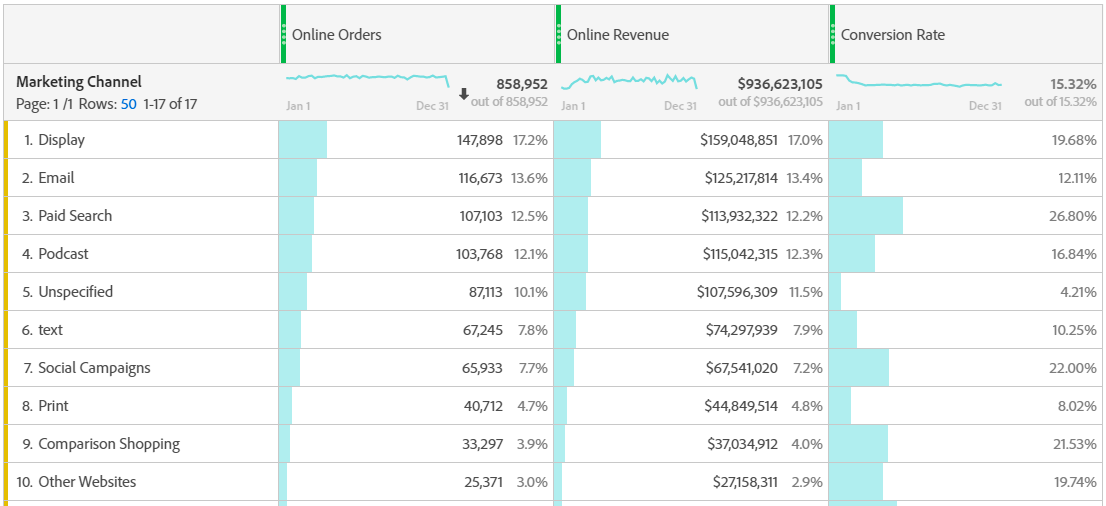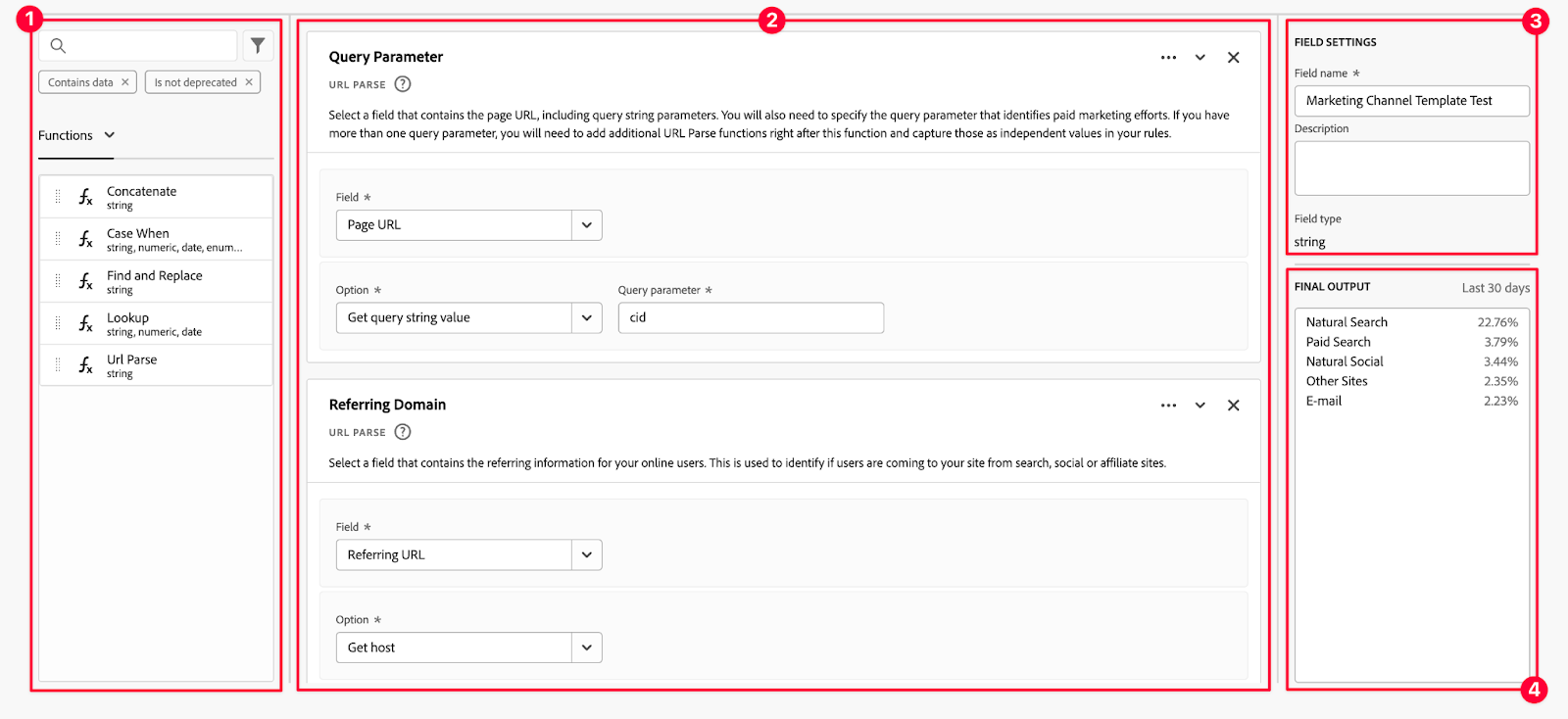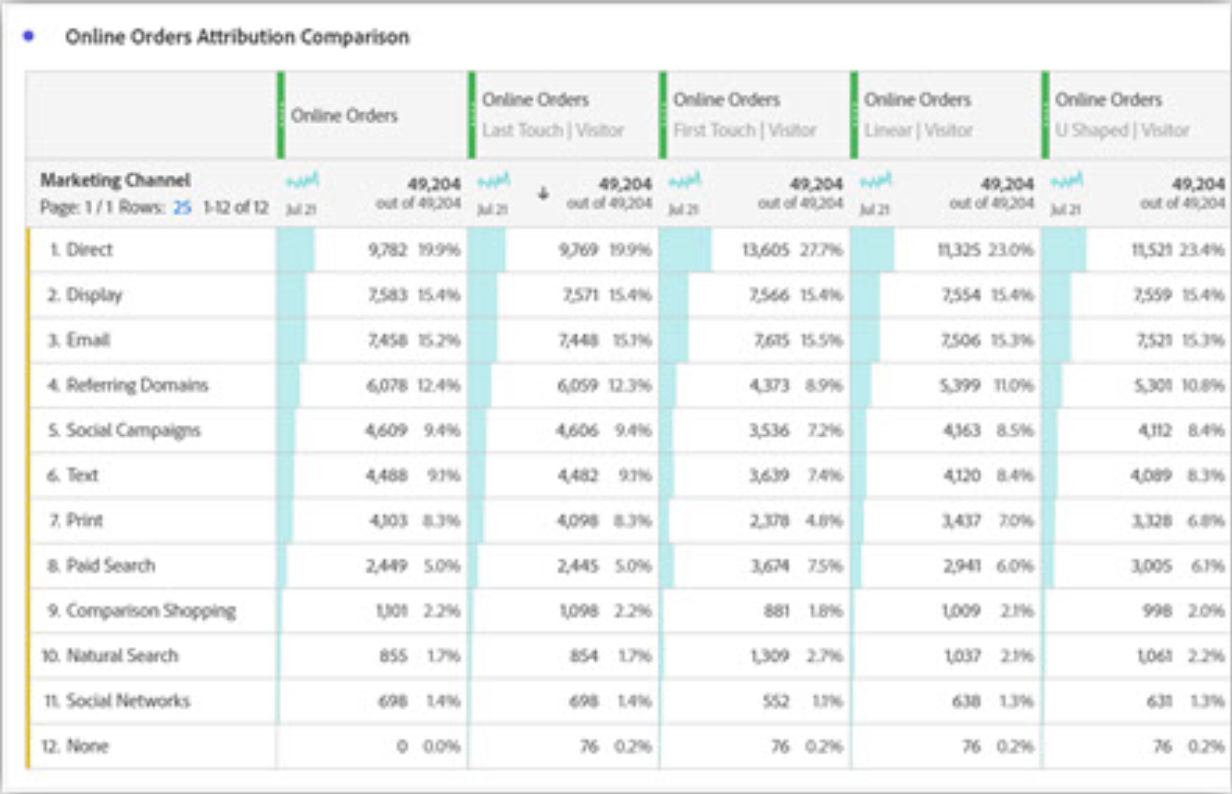From Tags to Channels: Crafting a Governance Blueprint for Adobe Analytics and Customer Journey Analytics

In the realm of digital analytics, understanding the nuances of user behavior is critical for optimizing marketing strategies. An organization’s marketing channels can offer a detailed view of the customer journeys critical to driving high engagement and incrementality. Adobe Analytics and Adobe Customer Journey Analytics are powerful tools that can provide the insights businesses need.
Although both Adobe Analytics and Customer Journey Analytics offer robust features to process marketing channel data, they require collaboration and alignment to faithfully represent a company’s business needs through a series of rules to categorize web traffic.
The marketing channels in Adobe Analytics and Customer Journey Analytics employ funnel logic—a system of rules layered upon one another to meticulously categorize incoming traffic. This layered approach enables a granular examination and prioritization of user interactions based on predefined campaign criteria, offering marketers a deeper understanding of the effectiveness of each tactic and each marketing channel.
By tracing the customer journey back to its origin, marketers can identify the touchpoints that played a pivotal role in driving desired actions. This insight empowers marketing teams to allocate resources more effectively, focusing on channels that yield the highest returns. In essence, attribution exercises facilitated by the proper configuration of the marketing channels can help define a roadmap for optimizing marketing efforts and maximizing ROI.
Consider the following example questions that can be answered by properly defining the marketing channel logic:
- Which channels drive the most visits and conversions?
- What is the user journey from the initial touchpoint to conversion?
- How do different marketing channels complement or overlap with each other?

By tracing the customer journey back to its origin, marketers can identify the touchpoints that played a pivotal role in driving desired actions.
Source: Adobe Experience League
By addressing the above questions, marketers can refine their strategies, ensuring that efforts are honed in where they are most impactful, ultimately enhancing the overall effectiveness of their digital marketing campaigns. In the dynamic landscape of online interactions, the marketing channel dimension becomes an invaluable ally, guiding marketers toward data-driven decisions and more successful customer engagement.
Migrating from Adobe Analytics to Adobe Customer Journey Analytics: Ensuring Data Quality
The transition from Adobe Analytics to Adobe Customer Journey Analytics presents a prime opportunity to fine-tune your data strategy. Before diving into the migration process, it's prudent to take a step back and evaluate not only the cleanliness of your existing data but also to be aware of critical differences between the two technologies and prepare your data.
Addressing inconsistencies, classifying data accurately, and removing unnecessary information can help optimize the migration process by providing a new clean slate of accurate web data and paving the way for a seamless and more efficient migration, minimizing potential challenges that may arise from data discrepancies.
Returning to the fundamentals of tracking is also a key step before defining or making changes to an organization’s marketing channels. Reassess campaign taxonomy to ensure it aligns with evolving business objectives.
By updating solutions with relevant data points, analytics infrastructure is equipped to adapt to changes in marketing strategies, shifting customer behaviors, and evolving industry trends. This forward-thinking approach ensures that marketing channels reflect current needs and lays the groundwork for a system that can easily accommodate future adjustments.
In an ideal state, collaborative efforts among internal teams can help fix and provide clean data from the source. Establishing a unified understanding of data standards and practices across departments fosters a cohesive analytics environment. This collaboration sets the stage for ongoing data governance.
However, a worst-case scenario is quite common and may involve constraints in cleaning up data at the source. In such situations, it's essential to recognize that all is not lost. Adobe Customer Journey Analytics offers flexibility in the form of derived fields. These fields allow for corrections and adjustments, providing a viable solution to ensure data integrity even when the primary source proves challenging to clean. This adaptability underscores the resilience of an analytics framework that can still deliver meaningful insights and drive informed decision-making, even when the data is not perfect at the source.
The journey from Adobe Analytics to Adobe Customer Journey Analytics is an opportune moment to refine your data practices. By addressing inconsistencies, revisiting tracking fundamentals, fostering internal collaboration, and leveraging the flexibility of analytics tools, you can ensure that your marketing channels are not just a reflection of the past but are well-equipped to meet the dynamic challenges of the future.
Cleaning and Classifying Data with Derived Fields
Adobe Customer Journey Analytics’ Derived Fields allow cleaning and/or classifying data after creating a connection to the source of data and before the data is available for reporting in the Data View.
Derived Fields are custom calculations or transformations applied to your data, providing a flexible way to address issues and enhance the quality of information. Using Derived Fields involves creating new fields based on existing data or modifying existing fields to meet specific cleanliness and consistency standards.
The potential uses for Derived Fields are virtually limitless. Besides cleaning and classifying, the tool also provides functions to replace, concatenate, split, trim, lowercase, and even create more complex setups through its “if this, then that” logic. This opens the door to creating entirely new and distinct data points for reporting without additional data sources.

The Derived Fields Interface:
- Selector: the selector area to select and drag and drop your function, function template, schema field, or standard field onto the rule builder.
- Rule builder: You build your derived field sequentially using one or more rules.
- Field Settings: You can name and describe your derived field and inspect its field type.
- Final Output: This area shows an on-the-fly updated preview of output values, based on data over the last 30 days.
Source: Adobe Experience League
By leveraging Derived Fields in Adobe Customer Journey Analytics, you gain a powerful tool for data cleaning and transformation without altering the original data source. This flexibility enables you to address specific issues, ensure data consistency, and maintain the integrity of your analytics for more accurate and reliable insights.
Recreating Marketing Channel Rules through Derived Fields
When migrating from Adobe Analytics to Customer Journey Analytics, it is best practice to document the existing marketing channels in Adobe Analytics. Creating a working document in a spreadsheet can help non-technical team members better understand the logic as applied in-platform, allowing for enhanced collaboration and more accurately defined marketing channels at the moment of migrating into CJA.
CJA provides a template for defining Marketing Channels using derived fields, streamlining the process of categorizing and analyzing incoming data. The derived fields template offers a convenient starting point to use the “Url Parse” and “Case When” functions multiple times, in layers, to fetch the values from a URL and classify traffic into specific marketing channels.
Below are a few logical steps to follow when migrating Marketing Channels from Adobe Analytics into Customer Journey Analytics:
- Using the marketing channel rules and criteria that were previously documented in the spreadsheet, create a derived field in Customer Journey Analytics to test the marketing channel rules.
- Align with the teams involved in the definition of the organization’s marketing channels to collect input and update the traffic channels with any new elements in your company’s marketing taxonomy.
- Assess and modify the criteria in your spreadsheet as needed to adapt it from Adobe Analytics to Customer Journey Analytics.
- Referrer
- Tracking Code (campaign parameters).
- Other query string parameters.
- Save the newly created Marketing Channel dimension.
- Compare previous marketing channels in AA with the new ones in CJA, the volumes should remain relatively stable (unless you made drastic changes to your traffic definitions when migrating)
- Iterate as Needed: Data cleaning is often an iterative process. If further adjustments or refinements are necessary, revisit the Derived Fields builder, modify the cleaning logic as needed, and repeat the process until the data meets your cleanliness standards.
The Importance of Governance on Marketing Channels
Governance is a linchpin for success in digital marketing and performance measurement, providing a structured framework to navigate the complexities of the various marketing channels. Defining governance around marketing channels is crucial for several reasons.
First, it allows organizations to explicitly outline the channels actively utilized—whether paid or organic. This clarity ensures that teams are aligned on the primary avenues through which traffic is generated, fostering a unified approach to marketing strategies.
Additionally, effective governance helps identify untapped opportunities by highlighting channels that might be overlooked or underutilized. By pinpointing areas with growth potential, organizations can strategically expand their reach and diversify their marketing efforts.
This proactive approach enables businesses to stay ahead of the curve and capitalize on emerging channels that could contribute significantly to their overall performance.
Beyond channel optimization, governance plays a pivotal role in streamlining existing processes: For example, to identify and eliminate legacy tagging that may no longer serve a purpose, prevent data clutter, and ensure that analytics efforts are focused on relevant, actionable insights.
Well-defined governance is a key advantage for establishing a unified approach to attribution across the organization. Without a standardized methodology, disconnected teams may interpret and measure attribution differently, leading to inconsistencies in performance evaluations.

Attribution exercises are useful to understand how the different marketing channels contribute in driving qualified traffic and conversions.
Source: Adobe Experience League
Aligning perspectives on measurement, data collection, and attribution can enable the creation of a unified measurement framework, further fostering collaboration across the organization to unlock the full potential of tools such as Adobe’s Real-Time CDP.
Governance: A Strategic Pillar for Data-Driven Organizations
Looking ahead, governance provides a forward-thinking mechanism to document and define new traffic sources that may emerge. In the ever-evolving landscape of digital marketing, staying ahead of the curve requires organizations to be agile and adaptable. By proactively documenting and defining new sources, businesses can seamlessly integrate emerging channels into their strategies, ensuring they are well-positioned to capitalize on evolving trends and technologies.
Governance around marketing channels is not merely a procedural formality; it is a strategic imperative. It serves as a compass, guiding organizations through the intricacies of diverse channels, fostering cohesion, and empowering teams to make data-driven decisions that drive performance and success in the competitive digital realm.




